Oak Ridge National Laboratory |
DOE FELLOW: Heidi Henderson
LOCATION: Oak Ridge National Laboratory
MENTOR: Dr.Eric Pierce
DOE Fellow, Heidi Henderson, is currently in Tennessee for her summer internship with the Oak Ridge National Laboratory (ORNL) under the supervision of Eric M. Pierce, Ph.D., Applied Remediation Science Lead, within the Environmental Science Division. Ms. Henderson is gathering data from various departments for her thesis, Analysis of Outfall 211’s Discharge. She is utilizing the XPSWMM software package to develop a conceptual storm-water management model for the contributing drainage areas of Outfall 211 as well as sources from the adjacent buildings such as cooling water and condensate from various AC units and boiler make-up water from the Creep Laboratory. Ms. Henderson is developing an approach that will be extensible to the Y-12 National Security Complex. ORNL is acting as a test bed for Y-12 because the area of interest is at a smaller scale and both facilities were built using similar construction and drainage methods.
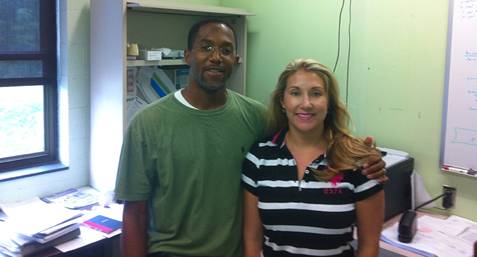
DOE Fellow, Heidi Henderson with mentor Dr. Eric Pierce at Oak Ridge National Laboratory
DOE FELLOW: Eric Inclan
LOCATION: Oak Ridge National Laboratory
MENTOR: Dr.Prashant Jain
Eric Inclan started his internship on June 4th at the Oak Ridge National Laboratory under the mentorship of Dr. Prashant Jain. During his internship, Eric is supporting the Thermal Hydraulics and Irradiation Engineering Group (THIE, a subdivision of the Reactor and Nuclear Systems Division), conducting research in fluid dynamics and heat transfer, using computational, analytical, and experimental methods. Currently, THIE has begun the in-house development of a lattice Boltzmann computational fluid dynamics (LBM CFD) package. The program is in the very early stages of development, but will ultimately serve as a tool for the simulation of reactor fluids. If successful, the LBM CFD package can reduce the cost and risks involved with conducting research on nuclear reactors and related components.
His tasks include writing a program for tagging boundary conditions and assisting in rewriting an open-source meshing program named CartGen. Currently, CartGen imports stereo-lithography files and produces a uniform or octree mesh in a Visual Toolkit format. The upgraded version of CartGen will read the tagged input, and generate a pre-processed lattice for the LBM package.
DOE FELLOW: Jaime Mudrich
LOCATION: Oak Ridge National Laboratory
MENTOR: Dr.Prashant Jain
In the summer of 2012, Jaime interned at the Oak Ridge National Laboratory in the Reactor and Nuclear Systems Division of the Thermal Hydraulics and Irradiation Engineering group under the mentorship of Dr. Prashant Jain. During this time, Jaime assisted in the development of the lattice Boltzmann method computational fluid dynamics tool, PRATHAM-3D ({P}a{RA}llel {T}hermal-{H}ydraulics simulations using {A}dvanced {M}esoscopic methods).Jaime’s tasks during the internship were benchmarking, optimization, and visualization.
To optimize PRATHAM with respect to speed and memory consumption, Jaime reviewed LBM and program optimization literature and made suitable alterations to the code. Also included in optimization efforts was the profiling of the code to see which subroutines were the most expensive and identify them as targets of optimization.
To verify the different features of PRATHAM, benchmark simulations were performed. Jaime was responsible for searching the literature for these cases and using PRATHAM to replicate the simulation. Among the features benchmarked were: density/pressure boundary conditions, velocity boundary conditions and body forcing. Benchmarking efforts were formally documented.
Jaime was also responsible for preparing visualizations of PRATHAM solutions. To prepare these images and videos, a parallel visualization tool developed by Lawrence Livermore National Laboratory called Visit was used. Jaime prepared 2D and 3D visualizations illustrating pressure, density, velocity and vortices distributions.

DOE Fellow Jaime Mudrich with Dr. Joshi at the High Flux Isotope Reactor
DOE-HQ EM-12 |
DOE FELLOW: Claudia Cardona
LOCATION: DOE-HQ EM-12 (Soil/Groundwater)
MENTOR: Kurt Gerdes
Claudia Cardona is participating in a summer internship at Department of Energy (DOE) Headquarters in Germantown, MD. She is working for the Office of Groundwater and Soil (EM-12), under the supervision of Mr. Kurt Gerdes. Claudia is assisting Mr. Paul Beam in reviewing and gathering data for the pump and treat systems located at DOE site: the location, area, major contaminants, remediation technologies, years of operation, status, gallons treated per year, capital and operating cost. Claudia is also revising the 2009 DOE Groundwater Plume Maps booklet and associated groundwater database. In addition, she is getting information directly from the sites to complete her assignment. This booklet compiles and shows the characteristics of contaminant plumes as well as the status of contamination and remedial approaches at major DOE sites to aid in the decision making for remediation prioritization. The compiled information will be used as an attachment to the end-states polices that are being developed by EM-12.
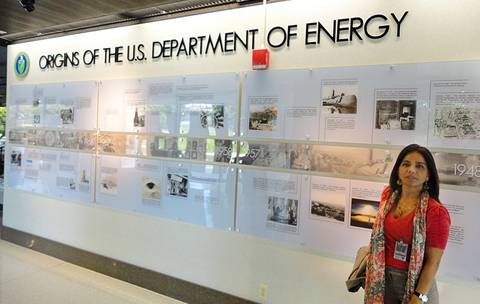
DOE Fellow Claudia Cardona at DOE-HQ EM-12
DOE-HQ EM-23 |
DOE FELLOW: Janty Ghazi
LOCATION: DOE-HQ EM-23 (Office of WTP and Tank Farm Program)
MENTOR: Dr. James Poppiti
Janty Ghazi is an electrical engineering master’s student currently conducting an internship at DOE Headquarters in Germantown, MD. He is working under the supervision of his mentor, Dr. James Poppiti, at EM-23 Office of WTP and Tank Farm Program. Presently, Janty is working on reviewing various reports and documents dealing with the waste treatment plant (WTP) being built out at the Hanford Site in order to better analyze the hydrogen in pipes and auxiliary vessels (HPAV) issue. This issue deals with the formation of hydrogen, an explosive gas, within various pipes and vessels throughout the WTP. Hydrogen is formed within the waste in three ways which include thermolysis, water and organic radiolysis, and corrosion. The reason hydrogen build up is an important issue is due to the possibility of igniting a pocket of hydrogen gas and the damage that would ensue from the resulting deflagration, detonation, or deflagration-to- detonation transition (DDT). These occurrences can lead to permanent deformation of pipes. This is of great concern in the black-cell areas of the plant which have been designed to be isolated, so repairs to that area would be extremely difficult or even impossible.
Mr. Ghazi has also worked on reviewing a request for approval of authorized limits for the release of personal property which was submitted to headquarters by the Idaho Cleanup Project. The request asks for changes to the limits for surface contamination of certain radioisotopes on personal property released to the public based on current exemptions at other DOE sites. It is important for Headquarters to carefully review such requests before approving them to make sure that they meet NRC and ANSI regulations. ALARA (as low as reasonably achievable) standards must also be strictly enforced, especially for items being released to the public.
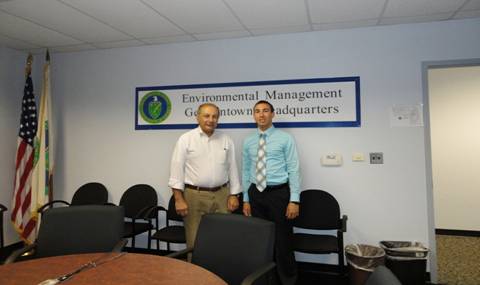
DOE Fellow Janty Ghazi with mentor Dr. James Poppiti at DOE-HQ EM-23
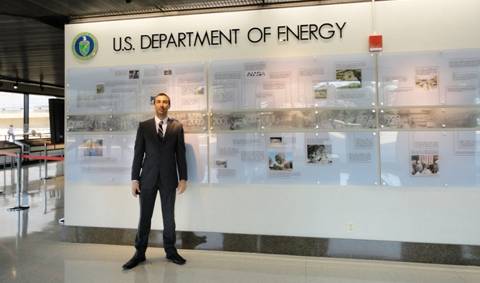
DOE Fellow Janty Ghazi at DOE-HQ EM-23
Y-12 National Security Complex
|
DOE FELLOW: Revathy Venkataraman
LOCATION: Y-12 National Security Complex in Oakridge, TN
MENTOR: Emma Jones, Jessica Metcalf, Dan Cannon, Andrew Dixson and Terry Richardson
Revathy Venkataraman started her internship on June 4th at Y-12 National Security Complex in Oakridge, TN. She is working on the EMBOS software under the supervision of Emma Jones and Jessica Metcalf and the EMBOS technical team Dan Cannon, Andrew Dixson and Terry Richardson.
EMBOS is an electronic medical records management system that is currently used at Y-12 medical offices to maintain medical histories, questionnaires, and manage case histories. It is also used to schedule patient appointments and store spirometry, X-ray, ECG, Vision, Audiometer and Urinalysis lab result files.
Revathy is designing and developing an automated .NET Batch Process to upload medical lab files to EMBOS oracle database. This will save time and help reduce manual work performed by lab assistants in uploading lab results to EMBOS.
Savannah River Site |
DOE FELLOW: Joshua Midence
LOCATION: Savannah River Site
MENTOR: Alez Cozzi
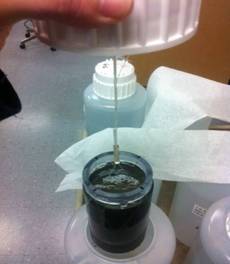 Joshua Midence is interning at the Savannah River Site (SRS) during the summer of 2012. Joshua is mentored by Alex Cozzi Ph.D., Materials Science.
Joshua Midence is interning at the Savannah River Site (SRS) during the summer of 2012. Joshua is mentored by Alex Cozzi Ph.D., Materials Science.
Savannah River National River (SRNL) has provided support to the Z-Area Salt Stone Facility in the past by evaluating different vault pouring strategies (curing conditions) on various properties of the grout. One of Joshua’s responsibilities is handling prepared simulated salt stone samples that have caustic materials infused. Joshua uses a testing method known as “leaching” in order to find the pH and conductivity of the deionized water surrounding the sample during different time intervals. He has also been measuring the compressive strength of the salt stone mixtures that are being mixed in order to absorb, some of the harsh chemicals and radio-nuclides that have been collected in the holding tanks at the Savannah River Site in Aiken, SC. Joshua is using a compression testing machine in order to measure the compressive strength of 3”x 6” cylinder salt stone samples which have different proportions of fly ash, Portland cement, and slag. He used theASTM: C39/C39M – 12 Standard Test Method for Compressive Strength of Cylindrical for all the samples tested.
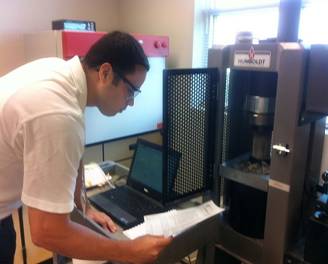
DOE Fellow Joshua Midence working on a Concrete Compression project
Washington River Protection Solutions |
DOE FELLOW: Ximena Prugue
LOCATION: Washington River Protection Solutions
MENTOR: Ron Calmus
Ximena Prugue is currently a summer intern at Washington River Protection Solutions (WRPS) in Richland, WA working under Ron Calmus and Leo Thompson as part of the Strategic Planning and Technology Group. Her scope of work consists of evaluating dry retrieval technologies for solid waste in Hanford’s single-shell tanks (SST) and observing the Mobile Arm Retrieval System (MARS) and control room activities. The MARS is a telerobotic arm based retrieval system capable of removing all types of tank waste including hard heel materials to well below 360 cubic feet, the allowed volume for a SST to be ready for closure. It consists of two systems: MARS-Sluicing and MARS-Vacuum. MARS-S is used for bulk retrieval on sound SSTs with waste up to 10ft in depth. Most of Ms.Prugue’s research focuses on the MARS-V which is used on leaking SSTs with waste depth up to 5 feet. The MARS-V can be deployed in nearly any leaking or potentially leaking Hanford Site SST with a large diameter central riser.
In collaboration with the engineers at Columbia Energy and Environmental Services (CEES), Ms. Prugue is data mining conceptual dry retrieval alternatives based on the MARS-V system. She is investigating several high-density solids pumps that can increase the 20 vol% sludge concentration for waste transport to reduce the amount of water used in retrieval. Cross-site transfer lines, however, cannot transfer waste slurries with a concentration of sludge greater than 20 vol% and often become plugged. Therefore, in addition to high-density solids pumps, Ms. Prugue is also investigating high-volume thin-film vacuum evaporator systems to quickly dry, package, and transport the tank waste to the Integrated Disposal Facility (IDF) instead of a DST to eliminate the need of a transfer slurry line.
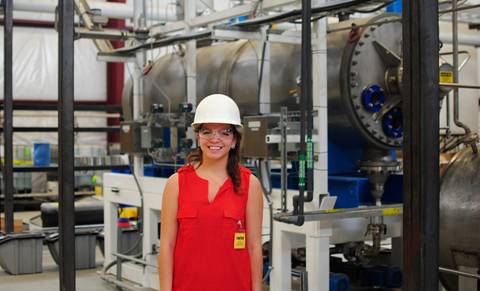
DOE Fellow Ximena Prugue at Washington River Protection Solutions (WRPS) in Richland, WA
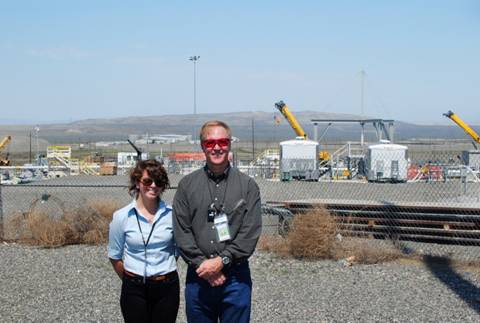
DOE Fellow Ximena Prugue with mentor Ron Calmus
Sullivan International Consulting
|
DOE FELLOW: Elicek Delgado-Cepero
LOCATION: Sullivan International Consulting – Chicago Office
MENTOR: Jennifer Knoepfle
This summer of 2012, DOE Fellow Elicek Delgado-Cepero is interning at Sullivan International Consulting Group, Inc. in Chicago, IL. Under the supervision of her mentor, Jennifer Knoepfle, Elicek is learning about different phases of the remedial investigation/feasibility study (RI/FS) for EPA and Superfund sites. The Chicago office of Sullivan, Inc. has a major contract with the U.S. Environmental Protection Agency (EPA) Region 5 to perform remedial work on Superfund sites in EPA Region 5. Sullivan has approximately 25 ongoing active projects where field and office studies are underway at any given time. Several of the projects have a scope of work defined as a remedial investigation (RI) and feasibility study (FS), by which the EPA decides what remedial action, if any, is appropriate for the site. The RI/FS is part of the EPA Comprehensive Environmental Response, Compliance, and Liability Act (CERCLA) Superfund cleanup process where sites listed on the National Priorities List (NPL) undergo site characterization, delineation, and assessment of contamination extent and appropriate identification and evaluation of remedial alternatives. Therefore, at Sullivan, Elicek has performed a variety of office tasks such as performing quality control on the sample data, creating maps in ArcGIS, and learning about different instrumentation devices for field sampling of volatile organic components (VOCs). Also, fieldwork still in progress includes site characterization such as measuring structures for an estimation of areas that will be removed, properly posting the Superfund Site areas as no trespassing, and photo logging sites where work is still in progress. Additional studies including identifying contamination sources were also performed.
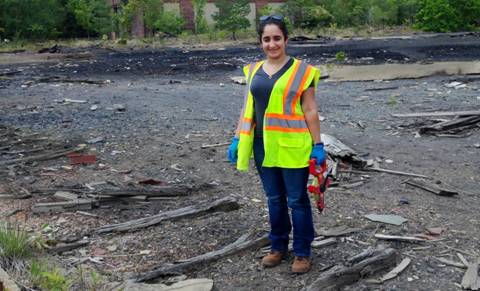
DOE Fellow Elicek Delgado-Cepero at Sullivan International Consulting Group, Inc.
in Chicago, IL
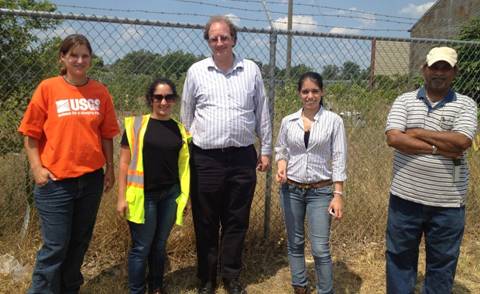
DOE Fellows Elicek Delgado-Cepero and Lilian Marrero with other team members
at Sullivan International Consulting Group, Inc.
DOE FELLOW: Lilian Marrero
LOCATION: Sullivan International Group, Inc. Chicago, IL.
MENTOR: Dr. Jennifer Knoepfle
Lilian Marrero started her internship on June 4th at Sullivan International Group, Inc. under the mentorship of Dr. Jennifer Knoepfle. Her project consists of performing a parallel study of volatile organic compounds (VOCs) contamination, specifically trichloroethene (TCE), at two Superfund sites: Industrial Site ‘P’ and Residential Site ‘L’. The selected sites are at various stages in the U.S. Environmental Protection Agency (US EPA) Comprehensive Environmental Response, Compensation, and Liability Act (CERCLA) “Superfund” cleanup process.
Industrial Site ‘P’ is at the end of the CERCLA Superfund cleanup process while Residential Site ‘L’ is at the remedial investigation/feasibility study (RI/FS) stage. Currently, groundwater and soil vapor continues to be sampled to monitor chemicals of concern (COC) changes due to past and on-going remediation and to ensure public safety at Industrial Site ‘P’. In contrast, Residential Site ‘L’ is in the early stages of the RI; the source and extent of contamination are yet to be identified. Field samples are in the process of being collected to assess whether impacted groundwater with TCE poses a vapor intrusion threat to residents. Lilian will analyze groundwater VOC data for the years 2007 and 2012 retrieved from wells strategically placed in six distinct groundwater zones strategically equivalent to the Exposition Aquifer (Exposition Zones ‘A’ through ‘E’) that exists beneath Industrial Site ‘P’. The 2007 data will serve as a baseline from which changes in contamination as a byproduct of the implemented remediation solutions may be assessed. Groundwater elevations for 2012 will be used to develop groundwater contour maps in an attempt to understand current groundwater flow patterns at the site. TCE plume maps will be developed for each zone along with chemical of concern (COC) box plots. Data extracted from 2007 through 2012 for soil sentry vapor (SSV) monitoring stations, specifically SSV-06 and SSV-07, will be reviewed in order to characterize soil gas VOCs near the residential areas adjacent to the Industrial Site ‘P’ Site.
Residential Site ‘L’ ground water contamination is present in the form of a plume. The contaminants of concern are chlorinated solvents (U.S. E.P.A., 2008). Soil–gas, sub-slab, and indoor air data will be collected at Residential Site ‘L’ during field visits. The data will be analyzed to determine if TCE concentrations are in violation of EPA standards. Similarly to Industrial Site ‘P’, groundwater contours, TCE plume maps and chemicals of concern box plots will be developed for Residential Site ‘L’. Based on the data analysis, an overview of the potential risk to the public as well as suggested clean up alternatives based on EPA screening criteria will be provided. If vapor intrusion is determined to be a threat at Residential Site ‘L’, then mitigation technologies will be recommended with the intent of minimizing to acceptable limits or completely eliminating human exposure to anthropogenic soil and groundwater contaminants.
During her internship, Lilian will also provide support by assisting in selected field activities, generating groundwater contours and contamination plumes in a geographic information system (GIS) for various projects, and performing quality control on chemical lab data packages, among other tasks.

DOE Fellow Lilian Marrero at Sullivan International Group, Inc.
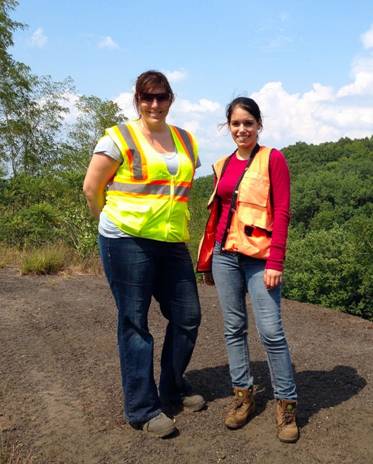
DOE Fellow Lilian Marrero with mentor Dr. Jennifer Knoepfle
Pacific Northwest National Laboratory in Richland, WA |
DOE FELLOW: Robert Lapierre
LOCATION: Pacific Northwest National Laboratory in Richland, WA
MENTOR: Dr. Dawn Wellman
Robert Lapierre is spending the summer of 2012 as an intern at the Pacific Northwest National Laboratory (Richland, WA) under the guidance of Dr. Dawn Wellman of the Environmental Systems Group. Over the course of 10 weeks, Robert will be trained in scanning electron microscope (SEM) analysis and perform research regarding the single-pass flow-through (SPFT) test as a system for corrosion evaluation.
In the past, SPFT testing has been done on glass, ceramics, and concrete. Mr. Lapierre’s research will be part of a new approach that uses SPFT to analyze the corrosion properties of metals, in monolith form, under carefully controlled conditions. The SPFT test is a single part of a range of tests that have been grouped and used to create a model for corrosion of a material of interest. The resulting model can be used to estimate and extrapolate corrosion data to over 10,000 years.
In addition to the SPFT testing, Mr. Lapierre was trained on the SEM by a PNNL technician for the analysis of his metal samples before and after the SPFT test. Robert has contributed to research in surfactant analysis, using a colorimetric crystal violet method to analyze surfactant content in samples.
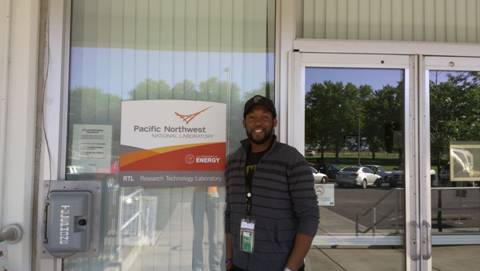
DOE Fellow Robert Lapierre at Pacific Northwest National Laboratory in Richland, WA
Tags: Internships
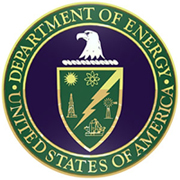
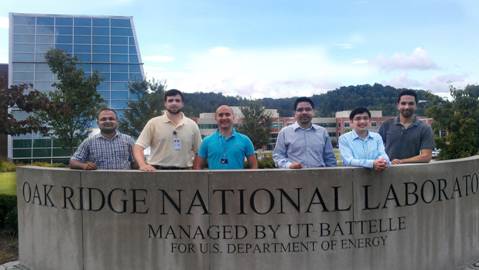
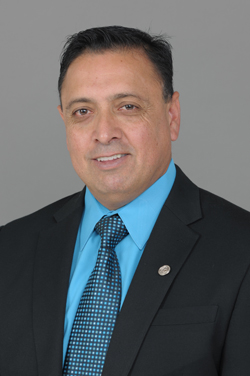 I wanted to let you know about an incredible opportunity made possible to FIU minority students thanks to the sponsorship and funding of the US Department of Energy’s Office of Environmental Management (DOE-EM). In an effort to overcome the challenges of an aging workforce, DOE-EM is actively and aggressively targeting college students across the US to enter DOE’s workforce.
I wanted to let you know about an incredible opportunity made possible to FIU minority students thanks to the sponsorship and funding of the US Department of Energy’s Office of Environmental Management (DOE-EM). In an effort to overcome the challenges of an aging workforce, DOE-EM is actively and aggressively targeting college students across the US to enter DOE’s workforce.